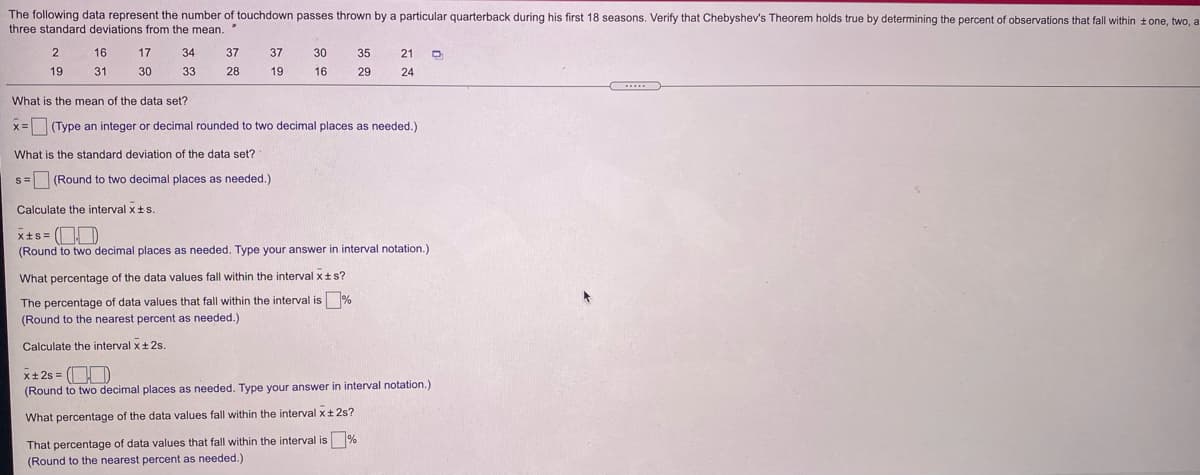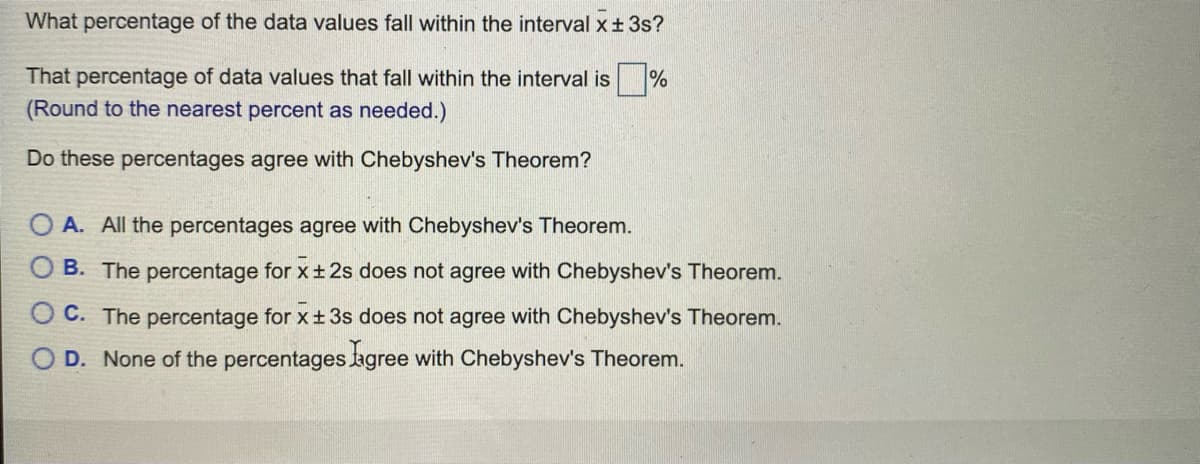The following data represent the number of touchdown passes thrown by a particular quarterback during his first 18 seasons. Verify that Chebyshev's Theorem holds true by determining the percent of observations that fa three standard deviations from the mean. 16 17 34 37 37 30 35 21 19 31 30 33 28 19 16 29 24 What is the mean of the data set? x= (Type an integer or decimal rounded to two decimal places as needed.) What is the standard deviation of the data set? s= (Round to two decimal places as needed.) Calculate the interval xts xts = (OD (Round to two decimal places as needed. Type your answer in interval notation.)
The following data represent the number of touchdown passes thrown by a particular quarterback during his first 18 seasons. Verify that Chebyshev's Theorem holds true by determining the percent of observations that fa three standard deviations from the mean. 16 17 34 37 37 30 35 21 19 31 30 33 28 19 16 29 24 What is the mean of the data set? x= (Type an integer or decimal rounded to two decimal places as needed.) What is the standard deviation of the data set? s= (Round to two decimal places as needed.) Calculate the interval xts xts = (OD (Round to two decimal places as needed. Type your answer in interval notation.)
Glencoe Algebra 1, Student Edition, 9780079039897, 0079039898, 2018
18th Edition
ISBN:9780079039897
Author:Carter
Publisher:Carter
Chapter10: Statistics
Section10.4: Distributions Of Data
Problem 19PFA
Related questions
Question

Transcribed Image Text:The following data represent the number of touchdown passes thrown by a particular quarterback during his first 18 seasons. Verify that Chebyshev's Theorem holds true by determining the percent of observations that fall within tone, two, a
three standard deviations from the mean. "
16
17
34
37
37
30
35
21
19
31
30
33
28
19
16
29
24
What is the mean of the data set?
x=(Type an integer or decimal rounded to two decimal places as needed.)
What is the standard deviation of the data set?
s= (Round to two decimal places as needed.)
Calculate the interval xts.
x+s = OD
(Round to two decimal places as needed. Type your answer in interval notation.)
What percentage of the data values fall within the interval xts?
The percentage of data values that fall within the interval is %
(Round to the nearest percent as needed.)
Calculate the interval x+ 2s.
x+2s = (D
(Round to two decimal places as needed. Type your answer
interval notation.)
What percentage of the data values fall within the interval x+2s?
That percentage of data values that fall within the interval is %
(Round to the nearest percent as needed.)

Transcribed Image Text:What percentage of the data values fall within the interval x+ 3s?
That percentage of data values that fall within the interval is
(Round to the nearest percent as needed.)
Do these percentages agree with Chebyshev's Theorem?
A. All the percentages agree with Chebyshev's Theorem.
O B. The percentage for x+ 2s does not agree with Chebyshev's Theorem.
O C. The percentage for x ±3s does not agree with Chebyshev's Theorem.
O D. None of the percentages agree with Chebyshev's Theorem.
Expert Solution
This question has been solved!
Explore an expertly crafted, step-by-step solution for a thorough understanding of key concepts.
This is a popular solution!
Trending now
This is a popular solution!
Step by step
Solved in 2 steps

Recommended textbooks for you

Glencoe Algebra 1, Student Edition, 9780079039897…
Algebra
ISBN:
9780079039897
Author:
Carter
Publisher:
McGraw Hill

Mathematics For Machine Technology
Advanced Math
ISBN:
9781337798310
Author:
Peterson, John.
Publisher:
Cengage Learning,

Glencoe Algebra 1, Student Edition, 9780079039897…
Algebra
ISBN:
9780079039897
Author:
Carter
Publisher:
McGraw Hill

Mathematics For Machine Technology
Advanced Math
ISBN:
9781337798310
Author:
Peterson, John.
Publisher:
Cengage Learning,